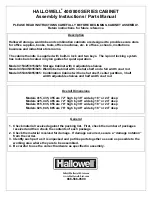
356
DS6000 Series: Concepts and Architecture
When considering the number of ranks, take into account the maximum disk operations per
second per rank as shown in Table B-3. These are measured at 100% DDM Utilization with
no cache benefit and with the average I/O being 4KB. Larger transfer sizes will reduce the
number of operations per second.
Based on these values you can calculate how many host I/O per second each rank can
handle at the recommended utilization of 40%. This is shown for workload read-write ratios of
70% read and 50% read in Table B-3.
Table B-3 Disk operations per second per RAID rank
As can be seen in Table B-3, RAID-10 can support higher host I/O rates than RAID-5.
However, you must balance this against the reduced effective capacity of a RAID-10 rank
when compared to RAID-5.
Sharing ranks between iSeries and other servers
As a general guideline consider using separate extent pools for iSeries workload and other
workloads. This will isolate the I/O for each server.
However, you may consider sharing ranks when the other servers’ workloads have a
sustained low disk I/O rate compared to the iSeries I/O rate. Generally, iSeries has a
relatively high I/O rate while that of other servers may be lower – often below one I/O per GB
per second.
As an example, a Windows file server with a large data capacity may normally have a low I/O
rate with less peaks and could be shared with iSeries ranks. However, SQL, DB or other
application servers may show higher rates with peaks, and we recommend using separate
ranks for these servers.
Unlike its predecessor the ESS, capacity used for logical units on the DS6000 can be reused
without reformatting the entire array. Now, the decision to mix platforms on an array is only
one of performance, since the disruption previously experienced on ESS to reformat the array
no longer exists.
Connecting via SAN switches
When connecting DS6000 systems to iSeries via switches, you should plan that I/O traffic
from multiple iSeries adapters can go through one port on a DS6000 and zone the switches
accordingly. DS6000 host adapters can be shared between iSeries and other platforms.
RAID rank type
Disk ops/sec
Host I/O/sec
(70% read)
Host I/O/sec
(50% read)
RAID-5 15K RPM (7 + P)
1700
358
272
RAID-5 10K RPM (7 + P)
1100
232
176
RAID-5 15K RPM (6 + P + S)
1458
313
238
RAID-5 10K RPM (6 + P + S)
943
199
151
RAID-10 15K RPM (3 + 3 + 2S)
1275
392
340
RAID-10 10K RPM (3 + 3 + 2S)
825
254
220
RAID-10 15K RPM (4 + 4)
1700
523
453
RAID-10 15K RPM (4 + 4
1100
338
293
Summary of Contents for System storage DS6000 Series
Page 2: ......
Page 5: ...iii...
Page 6: ...iv DS6000 Series Concepts and Architecture...
Page 18: ...xvi DS6000 Series Concepts and Architecture...
Page 24: ...xxii DS6000 Series Concepts and Architecture...
Page 26: ...2 DS6000 Series Concepts and Architecture...
Page 44: ...20 DS6000 Series Concepts and Architecture...
Page 46: ...22 DS6000 Series Concepts and Architecture...
Page 68: ...44 DS6000 Series Concepts and Architecture...
Page 88: ...64 DS6000 Series Concepts and Architecture...
Page 136: ...112 DS6000 Series Concepts and Architecture...
Page 138: ...114 DS6000 Series Concepts and Architecture...
Page 218: ...194 DS6000 Series Concepts and Architecture...
Page 242: ...218 DS6000 Series Concepts and Architecture...
Page 266: ...242 DS6000 Series Concepts and Architecture...
Page 298: ...274 DS6000 Series Concepts and Architecture...
Page 352: ...328 DS6000 Series Concepts and Architecture...
Page 392: ...368 DS6000 Series Concepts and Architecture...
Page 396: ...372 DS6000 Series Concepts and Architecture...
Page 404: ...DS6000 Series Concepts and Architecture DS6000 Series Concepts and Architecture...
Page 405: ......
















































